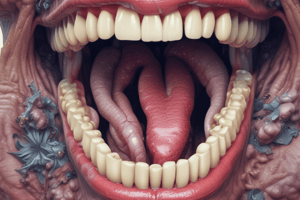Podcast
Questions and Answers
What part of the body does pseudomembranous candidiasis primarily affect?
What part of the body does pseudomembranous candidiasis primarily affect?
- Mouth (correct)
- Feet
- Lungs
- Liver
What is a common symptom of pseudomembranous candidiasis?
What is a common symptom of pseudomembranous candidiasis?
- Yellow patches in the mouth
- Blue patches in the mouth
- Green patches in the mouth
- White patches in the mouth (correct)
What can cause pseudomembranous candidiasis?
What can cause pseudomembranous candidiasis?
- Excessive sunlight exposure
- Increased vitamin C intake
- Antibiotic treatment disrupting natural body balance (correct)
- Regular dental check-ups
What might be found underneath the white patches in pseudomembranous candidiasis?
What might be found underneath the white patches in pseudomembranous candidiasis?
What is a potential consequence of untreated pseudomembranous candidiasis?
What is a potential consequence of untreated pseudomembranous candidiasis?
How can pseudomembranous candidiasis be diagnosed?
How can pseudomembranous candidiasis be diagnosed?
Which type of medications are commonly used for the treatment of pseudomembranous candidiasis?
Which type of medications are commonly used for the treatment of pseudomembranous candidiasis?
In what cases might systemic azoles like fluconazole be prescribed for pseudomembranous candidiasis?
In what cases might systemic azoles like fluconazole be prescribed for pseudomembranous candidiasis?
What is the primary preventive measure for pseudomembranous candidiasis?
What is the primary preventive measure for pseudomembranous candidiasis?
When might intravenous amphotericin B be required for treating pseudomembranous candidiasis?
When might intravenous amphotericin B be required for treating pseudomembranous candidiasis?
How might reducing stress levels contribute to preventing pseudomembranous candidiasis?
How might reducing stress levels contribute to preventing pseudomembranous candidiasis?
What are the symptoms associated with pseudomembranous candidiasis?
What are the symptoms associated with pseudomembranous candidiasis?
Study Notes
Candidiasis: Understanding Pseudomembranous Candidiasis
Candidiasis is a fungal infection caused by the Candida species of yeast. It can affect various parts of the body, including the mouth, throat, esophagus, lungs, and bloodstream. One particular form of candidiasis is pseudomembranous candidiasis, which primarily affects the mouth, tongue, inner cheeks, gums, tonsils, and the back of the roof of the mouth. This subtype often occurs due to antibiotic treatment causing damage to the natural balance of bacteria and fungi within our bodies.
Symptoms and Diagnosis
Pseudomembranous candidiasis presents with white patches inside the mouth, on the tongue, or elsewhere in the mouth. These patches are typically removable, revealing red areas underneath. Other symptoms may include burning sensations, difficulty swallowing, cracking at the corners of the lips, and soreness of the mouth and tongue. In some cases, it can cause red spots around the teeth, known as oral thrush, along with a cottony feeling in the mouth. If left untreated, this condition can lead to chronic inflammation and potentially life-threatening systemic infections.
Diagnosing pseudomembranous candidiasis involves confirming its presence through physical examination and sometimes further testing. A simple inspection of the patient's mouth will show the characteristic lesions; however, swabbing the affected area and sending it off for laboratory analysis might also be necessary.
Treatment and Prevention
Treatment for pseudomembranous candidiasis consists of topical antifungal medications such as nystatin and clotrimazole. Systemic azoles like fluconazole may be prescribed if your immune system isn't functioning properly. Generally, the medication is applied directly onto the infected area. In more severe cases where oral thrush has spread into the esophagus, intravenous amphotericin B may be required.
Preventing pseudomembranous candidiasis mainly involves maintaining good oral hygiene practices. Brushing your teeth regularly, flossing daily, and avoiding sugary foods and drinks can help prevent the overgrowth of candida. Refraining from smoking and reducing stress levels may also contribute to prevention. Additionally, maintaining a healthy immune system through proper nutrition and exercise is crucial.
In summary, pseudomembranous candidiasis is a type of candidiasis that impacts the mouth and other oral structures. Its symptoms include white patches, pain, and difficulty swallowing. Proper diagnosis can be made via visual examination or lab tests. Effective treatments involve antifungal medications both locally and systemically, depending on severity. Maintaining good oral health habits and overall wellbeing helps reduce the risk of contracting pseudomembranous candidiasis.
Studying That Suits You
Use AI to generate personalized quizzes and flashcards to suit your learning preferences.
Description
Explore the characteristics, symptoms, diagnosis, treatment, and prevention of pseudomembranous candidiasis, a form of fungal infection primarily affecting the mouth and oral structures. Learn about the causes, risk factors, and management strategies for this condition.




